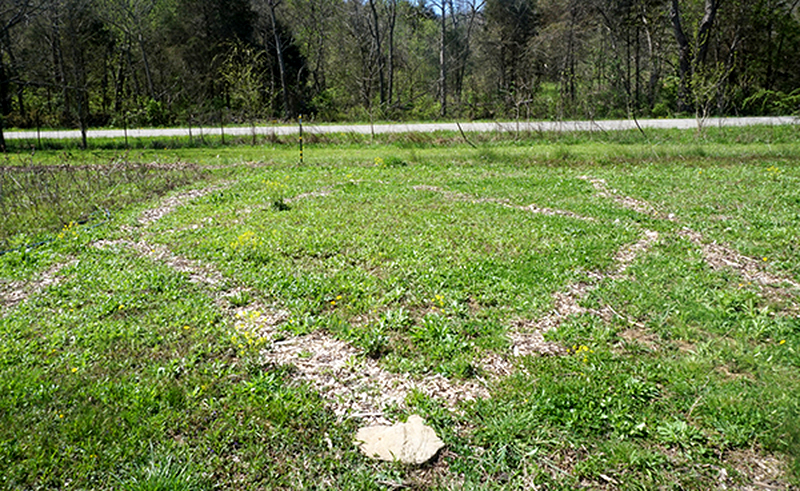
When it comes to cutting down weeds in small spaces, sometimes a lawn mower is not the right tool. I have an unusual space where even a string trimmer could be the wrong tool. Last fall, in my hasty decision to plant perennial herbs I’d been given, I designed a garden based on triangles. Rather than filling the triangular beds, I planted along the lines while leaving the middle open for future plants. I did this without really knowing how big the plants would get, whether they would spread and which ones I’d want to propagate. I thought I was leaving my options open. But what I really left open were several small spaces with unknown wild residents.

Perennials Poppin’
Much to my surprise, the perennial herbs I planted last fall survived the winter and sprung back to life. I found them in the cover crop of white clover and weedy volunteers—dandelion, thistle, dock, wild onions and hairy vetch. While the chaotic cluster might be acceptable within the privacy of a tucked-away back yard, this garden is on a friend’s property, where I enjoy gardening with my buddies. In our shared space, I need to be respectful of the overall standards and expectations. This awkwardly impractical shape for a lawn mower is surrounded by other fields that have to be mowed as well as gardens that are linear and orderly.
For my small, oddly shaped garden bed, I borrowed a weed cutter and learned how to swing it. I tried this new-to-me tool to knock back the weeds, keep them shorter than the planted herbs and to prevent the population explosion of their seed-heads. The weed cutter is double-bladed with a largely serrated edge. My first lesson in using it included making sure my feet were out of the way at all times. It would really, really hurt if I missed and hit my shin. The tool is angled in a way that reminds me of a golf putter. I try to keep my back straight while my arms are relaxed but controlled as I wave it across the field near my feet.

Get Into the Rhythm
After I started cutting, I found it to be a little bit addictive. When I use it, I get into a repetitive, meditative, whole-body rhythm. I work up a sweat, and I challenge my hands, forearms and the muscles along my sides. The most difficult aspect is controlling the momentum of the swinging blade. When I sense that I’m starting to get sloppy, I stop before I hurt myself.

A Preferred Tool
Reasons I like the double-bladed weed cutter tool:
- Understanding the tools I use is empowering. Years ago, I studied archeology and the ways people made all kinds of tools from sharp rocks such as flint. I have a healthy appreciation for a sharp edge, and I respect simplicity in design. It is satisfying to understand when something prevents a tool from functioning and then being able to fix it (which is much more complicated on a lawn mower than a weed cutter).
- My senses tell me what’s going on in my garden. Working in a garden is a holistic, full-body experience, and the idea of a polluting, noisy, vibrating machine presents a big obstacle for the peaceful, quiet growth that I want to experience. With the cutter, my feet sense the subtle changes in plant texture and variations in topography as I step carefully and consciously. The steps I take and the swings of the weed cutter produce sounds that vary with different vegetation, the speed of the swing and the amount of moisture present in the plants or on their surfaces.
- I can practice control. Tiny purple skullcap flowers hidden beneath encroaching clover could easily be chopped to shreds with a string trimmer, but I can stop my tool in midswing before decapitating one of my medicinal herbs. I can pause easily to pick a daisy and set it aside for a bouquet before continuing to clear out the field around my plants. How many lawn mowers provide that kind of sensitivity and ability to respond?

A Natural Solution
The weed cutter makes mass weeding a more mindful experience, and the swish-swish-swish sounds accompany birdsong and breezes quite nicely. My intuitive garden design disregards machines. It is an intentional space made for me and my plants, not for mowers, tillers, trimmers or irrigation. No, none of those were priorities when I thought of a garden space where I’ll leisurely explore new herbs such as agrimony, skullcap, wormwood and all-heal. I wanted to take my time and learn how to harvest them, get to know their growth patterns and how the plants already there would affect them. This is a space for someone who loves to notice all the tiny things, such as spiders skating midair from fleabane to dandelion, honeybees foraging on flowers and the morning dew adding highlights to the weedy, wild beauty.




